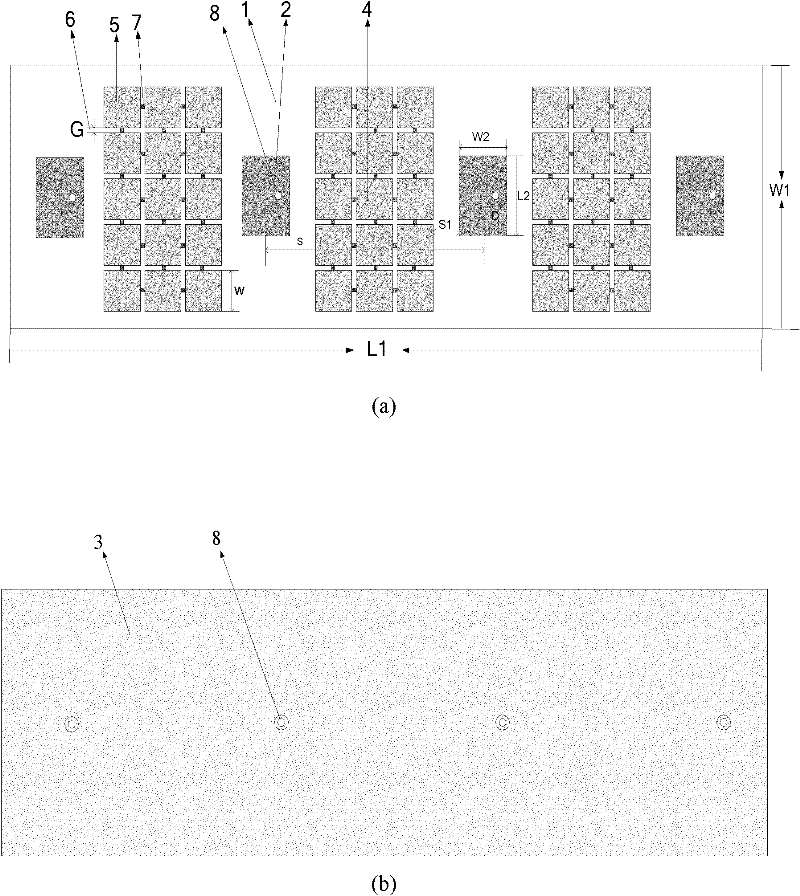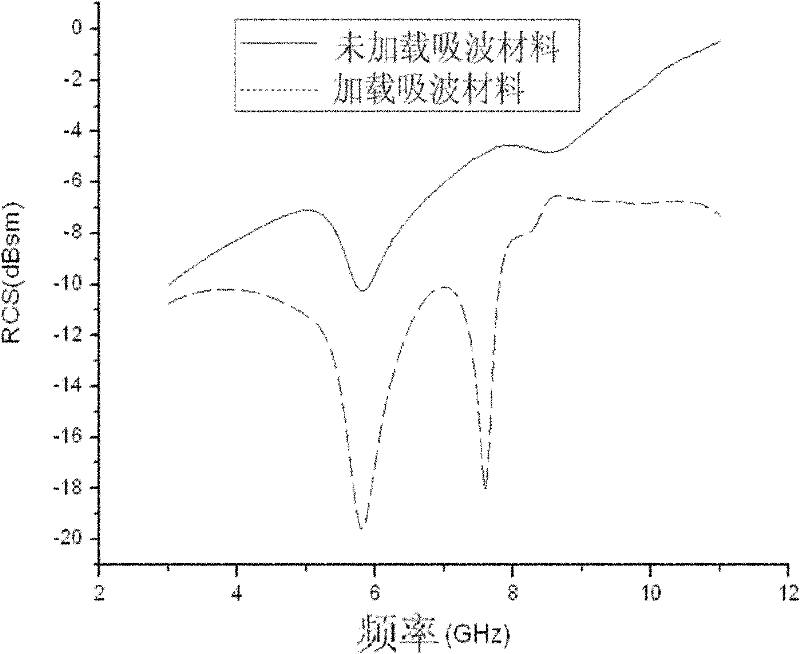Array antenna used for reducing radar scattering cross section
A radar cross-section and array antenna technology, applied in the field of array antennas, can solve problems such as difficulties, increase in antenna volume, weight and cost, and enhance RCS, and achieve the effects of easy processing, simple structure, and stable shrinkage performance
- Summary
- Abstract
- Description
- Claims
- Application Information
AI Technical Summary
Problems solved by technology
Method used
Image
Examples
Embodiment 1
[0028] The length L1 of the dielectric plate 1 is 3λ, the width W1 is λ, the relative dielectric constant is 4.4, and the thickness is 0.06λ. The length L2 of the microstrip radiation unit 2 is 0.3λ, the width W2 is 0.2λ, the diameter D of the via hole 8 is 1.3 mm, and the center distance S of two adjacent microstrip radiation units is 0.8λ. The length and width W of the square metal patch 5 are both 0.14λ, and the width G of the gap 6 between adjacent metal patches 5 is 0.02λ. The distance S1 between the structured wave absorbing material array 4 and the adjacent side of the microstrip radiation unit 2 is 0.075λ, and the resistance value of the resistor 7 is 150 ohms. The number of the microstrip radiating unit 2 is n=4, the upper surface is a radiating surface, the lower surface is a grounding surface, and the upper and lower surfaces are connected by SMA heads. The capacitance C can be adjusted by changing the width G of the gap 6 between the metal patches 5, the inductance...
Embodiment 2
[0030] The length L1 of the dielectric plate 1 is 6λ, the width W1 is λ, the relative dielectric constant is 4.4, and the thickness is 0.03λ. The length L2 of the microstrip radiation unit 2 is 0.3λ, the width W2 is 0.2λ, the diameter D of the via hole 8 is 1.3 mm, and the center distance S between two adjacent microstrip radiation units is λ. This embodiment is a cross metal patch, and its length and width W are both 0.05λ, and the width G of the gap 6 between adjacent metal patches 5 is 0.06λ. The distance S1 between the structured wave absorbing material array 4 and the adjacent side of the microstrip radiation unit 2 is 0.32λ, and the resistance value of the resistor 7 is 500 ohms. The number of microstrip radiating units 2 is n=8, the upper surface is a radiating surface, the lower surface is a grounding surface, and the upper and lower surfaces are connected by SMA heads. The capacitance C can be adjusted by changing the width G of the gap 6 between the metal patches 5, ...
Embodiment 3
[0032] The length L1 of the dielectric plate 1 is 25λ, the width W1 is λ, the relative dielectric constant is 4.4, and the thickness is 0.02λ. The length L2 of the microstrip radiation unit 2 is 0.3λ, the width W2 is 0.2λ, the diameter D of the via hole 8 is 1.3 mm, and the center distance S of two adjacent microstrip radiation units is 2λ. This embodiment is a circular metal patch, the diameter W of which is 0.5λ, and the width G of the gap 6 between adjacent metal patches 5 is 0.01λ. The distance S1 between the structured wave-absorbing material array 4 and the adjacent side of the microstrip radiation unit 2 is 0.15λ, and the resistance value of the resistor 7 is 1 ohm. The number of microstrip radiating units 2 is n=128, the upper surface is a radiating surface, the lower surface is a grounding surface, and the upper and lower surfaces are connected by SMA heads. The capacitance C can be adjusted by changing the width G of the gap 6 between the metal patches 5, the inducta...
PUM
| Property | Measurement | Unit |
|---|---|---|
| Resistance | aaaaa | aaaaa |
| Diameter | aaaaa | aaaaa |
| Resistance | aaaaa | aaaaa |
Abstract
Description
Claims
Application Information
 Login to View More
Login to View More - R&D
- Intellectual Property
- Life Sciences
- Materials
- Tech Scout
- Unparalleled Data Quality
- Higher Quality Content
- 60% Fewer Hallucinations
Browse by: Latest US Patents, China's latest patents, Technical Efficacy Thesaurus, Application Domain, Technology Topic, Popular Technical Reports.
© 2025 PatSnap. All rights reserved.Legal|Privacy policy|Modern Slavery Act Transparency Statement|Sitemap|About US| Contact US: help@patsnap.com



